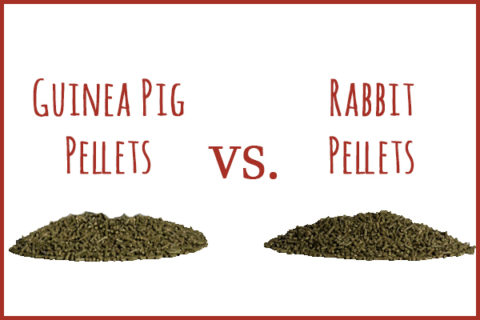Can guinea pigs eat rabbit pellets? If you have buns and cavies, this is a question that may come up at some point or another. At a glance, both pellets look the same. Many people who have both furry friends in their lives might assume that it's fine to give a piggy some rabbit pellets if they run out of food. Pellets are pellets, right? So surely it can't do that much harm for your rabbit and guinea pig to share a meal or few? Although these pellets look the same, there are some very big differences that can make a big impact on your piggy's health. Feeding a guinea pig rabbit pellets is extremely dangerous – in some cases, your cavy may end up facing deadly health issues such as scurvy.
The reason that it's never good to get confused between guinea pig pellets and rabbit pellets comes down to the content of the pellets. Guinea pigs need foods that are high in vitamin C, as their bodies cannot produce this vitamin naturally (much like humans). Their pellets contain stabilized vitamin C that can be easily absorbed. Rabbit pellets, on the other hand, don't have this addition. Other things that rabbit pellets lack are protein and fiber. Rabbits do not need the same amount of these nutrients, which means that your piggy will not have what she needs in her diet. Some rabbit pellets also contain fat in the form of seeds or other ingredients that piggies cannot digest.
What should you know about the differences between these pellets? In this guide, we tell you a little more about why guinea pigs shouldn't eat rabbit pellets.
They look the same, smell the same, and taste the same (what, you don't sample?) so how bad can it be to feed guinea pigs rabbit pellets? Especially if you're a slave to both species, it seems easier to just order one or the other. Unfortunately, not all pellets are created equal. Guinea pigs have unique dietary needs and (good) pellet brands are specially formulated to provide everything they need.
What makes a good pellet?
Plain, timothy hay-based pellets are best for adult guinea pigs over six months old. Pellet mixes that contain colorful bits, nuts, and seeds are fattening, a choking hazard, and can encourage selective eating. Guinea pigs will tend to pick out the tasty treats, but leave behind the healthy pellets.
These icky types of pellets are also usually alfalfa-based. Alfalfa hay is high in calcium and protein. It can be a valuable addition to a baby, growing guinea pig's diet, but the rich legume can cause health issues like bladder stones and obesity if fed regularly to adults. High-fiber grass hay, like timothy or orchard, is essential for a guinea pigs' digestion. While not a replacement for long-strand, loose hay, pellets with timothy hay as the first ingredient are a healthy addition to a balanced diet.
The issue with rabbit pellets
In addition to the qualities of a great, boring-looking pellet mentioned above, there is one more feature key to healthy guinea pig pellets. Let's hear it for stabilized vitamin C. Not any old form will do, either.
Vitamin C degrades quickly. That's why those drops for the water are pretty much useless after a few hours. Temperature and humidity can impact the vitamin C in pellets, so proper storage is important. Stabilized vitamin C is less likely to break down, meaning these pellets will retain their nutritional value longer. L-Ascorbyl-2-Monophosphate is a newer, modified form of ascorbic acid that is both time and heat stable, which means the vitamin C is available in pellets for much longer. Check those ingredient lists!
One of the main differences between a guinea pig and rabbit’s dietary needs is the addition of vitamin C. Popcorn points for the stabilized kind. Guinea pigs, like humans, are unable to make their own vitamin C. Because their bodies cant synthesize or store it, they need to receive around 10-30 mg per day through their diet. Guinea pigs that don’t get enough vitamin C are at risk for scurvy. Rabbits don't have this same need. Lucky buns.
The lesser of two evils
If in a pinch and you need to make a decision between a low-quality guinea pig pellet and a high-quality rabbit pellet (no antibiotics added), go with the timothy-based rabbit pellet. Adult guinea pigs just don't need the junk food that comes in many mixes.
That being said, it's absolutely necessary to make sure guinea pigs are receiving at least 25 mg of vitamin C each day. This can be in the form of extra vitamin C-rich vegetables like bell peppers or a vegetarian chewable tablet. If going without guinea pig pellets*, both is ideal. Remember, when feeding 1/8-1/4 cup of guinea pig pellets with stabilized vitamin C in addition to a cup of fresh vegetables daily, most healthy guinea pigs will not need a supplement.
*Psst. Try auto-ship and never run out of guinea pig pellets again.
References:
https://www.dsm.com/markets/anh/en_US/Compendium/companion_animals/vitamin_C.html
https://rabbits.life/guinea-pig-food/
http://www.happycavy.com/what-can-guinea-pigs-eat/





